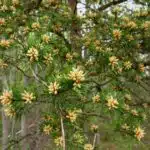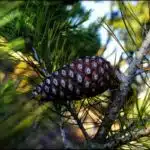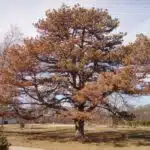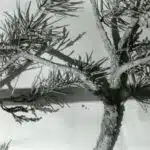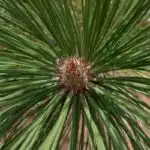Jeffrey Pine (Pinus jeffreyi) is a species of pine native to western North America, ranging from southern Oregon to northern Baja California in Mexico. This tree is highly valued for its ornamental qualities and its ability to withstand harsh environmental conditions, making it a popular choice for horticulturists and landscape designers alike.
Growing and caring for Jeffrey Pine requires a certain level of knowledge and expertise. From proper soil preparation to irrigation techniques, there are many factors that can influence the health and growth of this tree. In this article, we will provide an in-depth guide on how to grow and care for Jeffrey Pine, covering everything from planting tips to pruning techniques. Whether you’re a seasoned horticulturist or just starting out in the world of gardening, this article will provide valuable insights into successfully cultivating this beautiful tree species.
Understanding The Characteristics Of Jeffrey Pine
Jeffrey pine (Pinus jeffreyi) is a species of coniferous tree native to the western United States. It is a member of the Pinaceae family, and it can grow up to 180 feet tall with a trunk that measures up to four feet in diameter. The bark of Jeffrey pine is thick, scaly, and deeply grooved, with a reddish-brown coloration that becomes darker as the tree ages.
One of the most striking features of Jeffrey pine is its needles. They are arranged in bundles of three and can measure up to eight inches long. The needles are bluish-green in color when they first emerge but become yellow-green as they mature. In autumn, they turn an attractive shade of orange-brown before falling off in winter. When crushed, the needles emit a strong aroma that some people describe as reminiscent of vanilla or butterscotch.
If you’re planning on growing Jeffrey pine, it’s important to choose the right location for planting. This species prefers well-drained soils that are slightly acidic and rich in organic matter. It also requires full sun exposure to thrive. Keep these factors in mind when selecting a spot for your tree, and you’ll be on your way to successfully growing and caring for this magnificent species.
Choosing The Right Location For Planting
- When selecting a site for planting Jeffrey pine, the amount of sunlight should be considered, as adequate sunlight is essential for healthy growth.
- Additionally, the soil type should be taken into account; Jeffrey pine prefers well-drained soils with a pH range of 5-7.
- Furthermore, Jeffrey pine should not be planted in soils with high levels of nitrogen or phosphorus as this can cause poor growth or discoloration of foliage.
- Lastly, when selecting a planting location for Jeffrey pine, it is important to minimize exposure to strong winds, as this can cause significant damage to the tree.
Sunlight
As a jeffrey pine horticulturist, it is important to understand the sunlight requirements of this species for optimal growth and survival. Jeffrey pines are adapted to thrive in full sun exposure and require at least six hours of direct sunlight per day. Without adequate sunlight, these trees may become stunted or diseased, making it crucial to choose a location with optimal exposure.
When choosing the right location for planting your jeffrey pine, consider the amount of sunlight available throughout the day. A south-facing slope or an open area with no shading trees or structures will provide ample sunlight for your tree’s needs. It is also important to note that jeffrey pines can tolerate some shade but only if it is minimal and not prolonged.
In summary, providing adequate sunlight is key to growing a healthy jeffrey pine tree. When selecting a planting site, ensure that it receives enough direct sunlight throughout the day while avoiding areas with excessive shade. By following these guidelines, you can give your jeffrey pine the best chance at thriving in its new environment.
Soil Type
As a jeffrey pine horticulturist, choosing the right location for planting is crucial to ensure the tree’s growth and survival. Apart from sunlight requirements, soil type also plays a significant role in a tree’s overall health. Soil pH and drainage requirements are essential factors that must be considered when selecting an appropriate location.
Jeffrey pines prefer well-draining soils with a pH range of 5.5 to 7.5. The soil should not retain water for prolonged periods as this can lead to root rot and other fungal diseases, eventually causing the tree’s death. To ensure optimal growth, it is recommended to plant jeffrey pines in sandy loam soil with excellent drainage capabilities.
Another important consideration when choosing the right location is the surrounding vegetation. Avoid planting near trees or plants that may have conflicting soil pH or moisture requirements as they can compete for resources and stunt the growth of your jeffrey pine tree.
In summary, choosing the right soil type is critical in ensuring that your jeffrey pine grows healthy and thrives in its new environment. A well-draining sandy loam soil with a pH range of 5.5 to 7.5 is ideal for this species. By considering these factors, you can help your jeffrey pine grow into a beautiful and sturdy tree that will provide benefits for years to come.
Preparing The Soil For Optimal Growth
Soil preparation is an essential step in growing healthy and robust Jeffrey pine trees. The soil should be prepared to provide optimal conditions for the roots to grow deep and strong, ensuring that they can support the tree’s growth and development. Before planting, it is crucial to prepare the soil adequately by testing its pH level, texture, and nutrient content.
To test the soil’s pH level, use a soil testing kit available at any gardening store or online. This test will help determine if the pH level of the soil is within the ideal range of 5.0-6.5 for optimal growth of Jeffrey pine trees. If necessary, you can adjust the pH level by adding lime or sulfur to reach the desired range.
The texture of the soil also plays a significant role in determining whether it is suitable for planting Jeffrey pines. Sandy loam soils are ideal as they allow for proper drainage while retaining enough moisture for healthy root growth. However, if your soil is too dense or clay-like, you may need to amend it with organic matter such as compost or peat moss to improve its texture.
- Use organic fertilizers like manure or compost
- Add mulch around newly planted trees
- Remove any debris from planting area
- Avoid using herbicides near planting site
- Consider using raised beds in areas with poorly draining soils
With proper soil preparation techniques, you can ensure that your Jeffrey pines will have a strong foundation on which to grow and thrive. In the next section, we will discuss watering and irrigation techniques that are critical to maintaining healthy trees throughout their lifespan.
Watering And Irrigation Techniques
Watering and Irrigation Techniques:
As a jeffrey pine horticulturist, it is crucial to understand the watering requirements of these trees. Jeffrey pines require adequate water to establish deep roots, which enable them to withstand drought conditions. However, overwatering can lead to root rot, which is detrimental to their growth. Therefore, it is essential to use efficient watering techniques that promote water conservation.
One recommended irrigation method for jeffrey pines is drip irrigation. Drip irrigation delivers water directly to the roots of the tree in small amounts, minimizing water loss through evaporation or runoff. This method also allows for precise control of water application and reduces weed growth around the base of the tree. Additionally, using mulch around the base of the tree can help retain soil moisture and prevent weed growth.
Water conservation techniques should also be incorporated when irrigating jeffrey pines. These techniques include scheduling irrigation during early morning or late evening hours when temperatures are cooler and less moisture evaporates from the soil surface. Checking soil moisture regularly and adjusting watering schedules based on weather conditions can also minimize excess water usage. By utilizing drip irrigation and incorporating water conservation techniques, jeffrey pine trees can be efficiently irrigated while promoting sustainable practices.
| Watering Technique | Pros | Cons |
|---|---|---|
| Drip Irrigation | Precise control of water application; minimizes weed growth; reduces water loss through evaporation or runoff | Requires initial setup cost; may require maintenance; risk of clogging |
| Sprinkler Irrigation | Covers large areas quickly; low installation cost; requires minimal maintenance | Can cause erosion; may promote weed growth; inefficient water usage |
| Flood Irrigation | Low installation cost; easy operation | Risk of soil erosion; inefficient water usage; not suitable for sloped terrain |
Moving on to fertilization and nutrient management…
Fertilization And Nutrient Management
Fertilization and Nutrient Management:
In order to grow healthy Jeffrey pines, it is important to ensure that they receive the necessary nutrients. Compost application is a great way to provide your trees with these nutrients. Apply compost around the base of the tree, making sure not to cover the trunk or foliage. This will provide essential nutrients such as nitrogen, phosphorus, and potassium.
Soil pH levels play an important role in nutrient uptake by plants, including Jeffrey pines. Ideally, the pH level should be between 5.5 and 6.5 for optimal nutrient absorption. If the soil pH level is too high or too low, it can affect tree growth and health. A soil test can help you determine if the pH level needs adjusting.
Here are some tips for fertilization and nutrient management for Jeffrey pines:
- Use organic fertilizers such as compost or manure.
- Do not over-fertilize as this can lead to excessive growth and weak branches.
- Avoid using chemical fertilizers as they can harm beneficial microorganisms in the soil.
- Regularly monitor soil pH levels and adjust if necessary.
- Follow manufacturer instructions when applying fertilizers.
Next up: Pruning and Shaping for Aesthetic Appeal…
Pruning And Shaping For Aesthetic Appeal
Pruning is essential for maintaining the health and aesthetic appeal of your Jeffrey pine tree. Decorative pruning can help maintain a desired shape, improve air circulation, and promote healthy growth. It’s important to prune your tree regularly, as this will prevent the need for more drastic measures in the future.
Many creative topiary designs can be achieved with Jeffrey pines, including spirals and cones. To create these shapes, start by removing any branches that are growing towards the center of the tree. Then, choose which branches you want to keep and begin shaping them using sharp pruning shears. Be sure to make clean cuts at a slight angle to prevent damage to the bark.
While pruning can improve the appearance of your tree, it’s also important to prioritize its health. Avoid over-pruning or removing too many branches at once, as this can cause stress and weaken the tree’s structure. Regularly inspect your tree for signs of pests or disease, as these issues can also affect its growth and appearance.
Moving on from pruning and shaping for aesthetic appeal, it’s crucial to address common pests and diseases that may affect your Jeffrey pine tree. By taking proactive measures to prevent infestations and infections, you can ensure your tree remains healthy and vibrant for years to come.
Dealing With Common Pests And Diseases
Pruning and shaping are crucial for promoting the aesthetic appeal of jeffrey pines. Proper pruning techniques ensure that the tree grows in a desired shape, which enhances its appearance. It’s essential to prune your jeffrey pine regularly during its early years to maintain an attractive form. Prune only the dead, damaged, or diseased branches to prevent further damage to the tree.
Preventing infestations is one of the best ways to keep your jeffrey pine healthy. Regularly inspecting your tree for signs of pests can help you detect them early before they cause significant damage. To prevent infestations, avoid planting new trees close together as this creates a favorable environment for pests such as bark beetles.
Fungal infections can also be detrimental to your jeffrey pine’s health. Fungi thrive in moist environments; therefore, it’s essential to ensure that you do not overwater your tree. Additionally, practicing proper pruning methods can help reduce fungal infections by increasing air circulation within the tree canopy.
- Use organic mulch around the base of your jeffrey pine to retain moisture and regulate soil temperature.
- Apply insecticides regularly during pest season.
- Avoid using chemical fertilizers on your jeffrey pine as they may harm beneficial organisms in the soil.
- Consult with a professional horticulturist if you suspect any pest or disease infects your jeffrey pine.
As a Jeffrey Pine horticulturist, I recommend following these tips to keep your tree healthy and vibrant. Prevention is always better than cure when dealing with pests and diseases; therefore, regular inspection and care are necessary. In the next section, we will explore propagation methods for Jeffrey Pine and how you can grow more pines from seeds or cuttings.
Propagation Methods For Jeffrey Pine
Jeffrey pine, a popular tree species in the western United States, can be propagated through various methods including seed, cuttings, and grafting. Seed propagation often yields the best results with high success rates as long as viable seeds are used. When collecting seeds from mature trees, it is essential to ensure that they are fully ripe and free of damage or disease. The collected seeds should be stored in a cool and dry place until ready for use.
Seed viability is crucial when propagating Jeffrey pine through this method. Seeds that are more than six months old may have lower germination rates and should be avoided. To increase germination rates, soaking seeds in water for 24-48 hours before planting can help soften their outer shells. Additionally, using rooting hormone during planting can also aid in seedling growth.
Overall, successful propagation requires consistent care and attention to detail. Rooting hormone should only be used in moderation to avoid overstimulation of the seedlings. During the initial stages of growth, it’s important to keep soil moist but not overly wet which can lead to root rot. Once seedlings are established, they can be transplanted into larger containers or directly into the ground with proper seasonal maintenance tips in mind such as watering schedules and pest management strategies.
As your Jeffrey pine grows, it’s important to stay on top of seasonal maintenance tasks such as pruning dead or diseased branches and monitoring for pests or diseases. By following appropriate care practices throughout its life cycle, your Jeffrey pine will thrive and continue to provide beauty and shade for years to come!
Seasonal Maintenance Tips
After successfully propagating your Jeffrey pine saplings, it’s important to know the proper seasonal maintenance tips to ensure their long-term growth and survival. One essential aspect of caring for your mature Jeffrey pine is to mulch around the base of the tree. This not only helps retain moisture in the soil during dry periods, but also regulates soil temperature and suppresses weed growth. Be sure to avoid piling mulch against the trunk, as this can lead to rot or disease.
Another crucial element of seasonal maintenance is winter protection. While Jeffrey pines are relatively tolerant of cold temperatures, prolonged exposure to sub-zero temperatures can damage or kill young trees. To prevent this, wrap the trunk of young trees with a protective layer of burlap or other insulating fabric. Additionally, consider applying an anti-desiccant spray to evergreen foliage in late fall to help prevent water loss during dry winter months.
Finally, it’s worth noting that proper care extends beyond just seasonal maintenance tasks. Regularly inspecting your tree for signs of pest infestations or disease is crucial for maintaining its health and vitality over time. Whether you’re an experienced horticulturist or new to growing Jeffrey pines, following these tips will help ensure that you enjoy the beauty and benefits of these majestic trees for years to come.
Enjoying The Beauty And Benefits Of Jeffrey Pine
Jeffrey Pine is a beautiful and versatile tree that can provide a myriad of benefits to its environment. Its striking appearance makes it an excellent choice for photographing or incorporating into a landscape design. The key to enjoying the beauty and benefits of Jeffrey Pine lies in understanding how to care for it properly.
To capture the essence of this majestic tree in a photograph, it’s important to choose the right time and lighting conditions. Early morning or late afternoon light can create stunning shadows and highlights that showcase the unique texture of the bark and needles. When framing your shot, consider including other elements such as rocks or wildflowers to add interest and depth.
When creating a landscape design inspired by Jeffrey Pine, it’s essential to take into account its specific needs. This species thrives in well-draining soil with plenty of sunlight, so be sure to choose an appropriate planting location. Consider complementing the tree with other native plants that share similar growing requirements for a cohesive and sustainable design.
Incorporating Jeffrey Pine into your environment can provide numerous benefits such as shade, wildlife habitat, and improved air quality. With proper care and attention, this remarkable tree can enhance any space while also contributing positively to the surrounding ecosystem.
Conclusion
Jeffrey Pine is a stunning evergreen tree that is native to the western regions of North America. As a horticulturist, it is important to understand the characteristics of this tree, including its growth habits and preferences for soil, water, and nutrients. When planting Jeffrey Pine, choosing the right location is key to ensuring optimal growth and health. Proper soil preparation and irrigation techniques are also essential for promoting healthy root development and foliage growth.
In addition to providing adequate care for your Jeffrey Pine, it is important to be aware of common pests and diseases that can threaten its health. By taking preventative measures and promptly addressing any issues that arise, you can help your tree thrive for years to come.
As a horticulturist, I highly recommend propagating Jeffrey Pine through seedlings or cuttings in order to ensure genetic diversity and maintain the species’ resilience against potential threats. With proper seasonal maintenance such as pruning and mulching, your Jeffrey Pine can continue to provide beauty and benefits for generations to come.
In conclusion, growing and caring for Jeffrey Pine requires attention to detail and an understanding of the unique needs of this species. By providing optimal conditions for growth, mitigating potential threats, and practicing proper propagation techniques, you can enjoy the beauty of this majestic tree in your landscape. As John Muir once said: “The clearest way into the Universe is through a forest wilderness.” Let us strive to preserve these natural wonders for future generations.
Image Credits
- “Eight Dollar Mountain & Jeffrey Pine Loop Trail” by BLM Oregon & Washington (featured)




